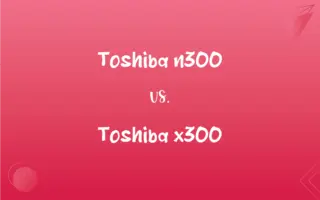LRT vs. MRT: What's the Difference?
Edited by Aimie Carlson || By Harlon Moss || Published on February 8, 2024
LRT (Light Rail Transit) typically operates at street level with lighter passenger capacity, while MRT (Mass Rapid Transit) is a heavy rail, high-capacity urban transit system.

Key Differences
LRT, or Light Rail Transit, is designed for lower passenger capacity and often integrates with street traffic. MRT, standing for Mass Rapid Transit, is characterized by its high passenger capacity and typically operates on exclusive rights of way.
The LRT system is usually less expensive to build and maintain due to its smaller scale and lower speed. MRT systems, on the other hand, require more investment but offer faster, high-capacity services, often crucial for larger cities.
LRT can be more flexible in terms of routes, often used to cover shorter distances within cities or suburban areas. MRT systems are designed for high-volume, high-speed transit, usually connecting major urban areas with suburbs or other cities.
LRT typically has more frequent stops and can be at street level, making it more accessible in dense urban areas. MRT stations are often spaced farther apart, focusing on speed and efficiency over short distances.
LRT often blends with urban environments, contributing to street-level activity and easier pedestrian access. MRT, with its larger scale infrastructure, can significantly shape urban development and land use around its stations and routes.
ADVERTISEMENT
Comparison Chart
Capacity
Lower passenger capacity
Higher passenger capacity
Operating Environment
Often at street level, mixed traffic
Exclusive rights of way, separate from traffic
Cost
Less expensive to build and maintain
More investment required
Speed and Efficiency
Slower, more stops
Faster, fewer stops
Urban Integration
Blends with urban areas, short distances
Influences urban development, long distances
ADVERTISEMENT
LRT and MRT Definitions
LRT
Often integrates with other traffic and pedestrian areas.
The LRT runs alongside cars in the city center.
MRT
Influences urban development and land use.
New commercial areas have developed around MRT stations.
LRT
Designed for shorter, more frequent stops.
The LRT stops at several key points in the city, aiding local transit.
MRT
Operates on exclusive, often underground, tracks.
The MRT runs underground, avoiding street-level traffic.
LRT
Can be a tram or streetcar system in urban settings.
The new LRT line serves as a modern tramway for commuters.
MRT
A high-capacity urban rail transit system.
The MRT connects major parts of the city with its rapid service.
LRT
Suited for medium-capacity urban transit needs.
The city's LRT system efficiently connects various neighborhoods.
MRT
Features fewer stops, catering to high-volume transit.
The MRT has fewer stops, ensuring a fast journey for daily commuters.
LRT
A public transport service operating at street level.
The LRT passed through the downtown area frequently.
MRT
Designed for faster travel over longer distances.
Commuters use the MRT for quick transit between distant suburbs and downtown.
FAQs
Can LRT integrate with other traffic?
Yes, LRT often shares space with other road traffic and pedestrians.
What does MRT stand for?
MRT stands for Mass Rapid Transit, a high-capacity urban rail system.
What is the capacity of an MRT?
MRTs have a higher passenger capacity, suited for mass urban transit.
What is LRT?
LRT (Light Rail Transit) is a public transit system designed for medium-capacity urban travel, often operating at street level.
How fast is LRT compared to MRT?
LRT is generally slower with more frequent stops, while MRT is faster with fewer stops.
Is MRT suitable for intercity travel?
MRT is mainly designed for urban transit, not typically for intercity travel.
Are LRT stations more accessible than MRT?
LRT stations, being at street level, are generally more accessible, especially in dense urban areas.
Do LRTs have frequent stops?
Yes, LRTs typically have more frequent stops for shorter distance travel.
Can LRT be expanded easily?
Yes, LRT systems can be relatively easier to expand or modify due to their smaller scale and integration with city streets.
Is LRT environmentally friendly?
LRT is generally considered environmentally friendly, especially when powered by electricity or other sustainable energy sources.
Does MRT operate above ground?
MRT can operate both above and below ground, depending on the urban landscape.
How does LRT affect urban traffic?
LRT can integrate with urban traffic, sometimes reducing road congestion by offering an alternative to car travel.
What type of tracks does MRT use?
MRT usually uses exclusive tracks, separate from other traffic, often elevated or underground.
Is MRT more expensive than LRT?
Yes, due to its larger scale and infrastructure, MRT is typically more expensive to build and maintain.
What areas do LRTs typically serve?
LRTs serve urban and suburban areas, focusing on medium-distance travel.
How does MRT impact urban development?
MRT can significantly influence urban development, often leading to growth around stations.
What is the primary purpose of LRT?
The primary purpose of LRT is to provide efficient, medium-capacity transit within cities.
Can MRT be part of a larger transit network?
Yes, MRT often forms the backbone of a city's larger public transit network.
Do MRT systems require significant infrastructure investment?
Yes, MRT systems involve substantial infrastructure development, including stations, tracks, and sometimes tunnels.
How does the cost of riding MRT compare to LRT?
The cost of riding MRT or LRT varies by city, but MRT may have higher operational costs due to its larger scale and efficiency.
About Author
Written by
Harlon MossHarlon is a seasoned quality moderator and accomplished content writer for Difference Wiki. An alumnus of the prestigious University of California, he earned his degree in Computer Science. Leveraging his academic background, Harlon brings a meticulous and informed perspective to his work, ensuring content accuracy and excellence.
Edited by
Aimie CarlsonAimie Carlson, holding a master's degree in English literature, is a fervent English language enthusiast. She lends her writing talents to Difference Wiki, a prominent website that specializes in comparisons, offering readers insightful analyses that both captivate and inform.







































































